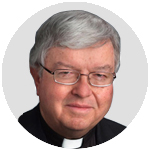
Q. Over the years, I have noticed that the question of how long the Advent candle is displayed and lighted varies widely from parish to parish. When I was growing up, the practice seemed to be that it was lighted on the First Sunday of Advent and concluded with the feast of the Epiphany.
But now, it seems, while virtually all parishes start on Advent’s first Sunday, the “end date” varies widely. The most ridiculous, in my opinion, is that some parishes cease using the Advent candle as of Christmas Eve. What is the official church teaching on the matter? I am “old-school,” and many others are as confused and disappointed as I am. (State of Georgia)
A. I am not sure that there is a definitive answer to your question (or any “official” church teaching on it), so we may just have to deal with some ambiguity.
The devotional use of the Advent wreath has a long tradition; in pre-Christian times, people would gather evergreens and light candles to counteract the darkness of winter and to show that “greener times” were on the horizon. Germans of the 16th century seem to have “Christianized” that custom with the Advent wreath, and the practice gradually spread throughout the Christian world as Germans emigrated.
[tower]
As you indicate, the manner of use varies somewhat. Universally, the first candle on the wreath is lighted on the first of the four Sundays of Advent, and then the other three on the three succeeding Sundays. Some parishes do cease using the wreath and remove it from the sanctuary when the first Mass of Christmas Eve is about to be celebrated. (I don’t really find that “ridiculous,” since the season of Advent does end with the celebration of Christ’s birth.)
In other parishes, though, a white candle is inserted in the center of the wreath — the “Christmas candle”; that candle (larger than the others) is then lighted at each liturgy throughout the Christmas season, which ends with the feast of the Baptism of Jesus, celebrated on the first Sunday after the Epiphany. Once Christmas has arrived, some parishes also replace the three purple and one rose candle with four white ones, symbolizing the church’s joy at the birth of the Christ Child.
Q. Can Catholics morally give donations to the Shriners Hospitals? Their ads are very convincing, but aren’t the Shriners Masons? (Surry, Virginia)
A. All Shriners are Masons. (The reverse, though, is not true. Shriners International began in 1872 as a spinoff of Freemasonry, with philanthropy as one of its principal goals.) Shriners Hospitals for Children is a network of 22 facilities across North America that specializes in treating children with orthopedic conditions, burns, spinal cord injuries and cleft lips and palates — all without regard to a family’s ability to pay.
True, Catholics have long been prohibited from joining the Masons since it is, at its core, a naturalistic religion. (Pope Leo XIII in 1884 said that Masonry had as its fundamental tenet “that human nature and human reason ought in all things be mistress and guide,” and the Vatican’s Congregation for the Doctrine of the Faith declared in 1983 that “the faithful who enroll in Masonic associations are in a state of grave sin.”)
Your monetary donation to the Shriners Hospitals, though, is given not to advance the spread of Masonic doctrine but simply to help offer compassionate care to children, and I would feel comfortable making such a donation.
***
Questions may be sent to Father Kenneth Doyle at askfatherdoyle@gmail.com and 30 Columbia Circle Dr., Albany, New York 12203.
PREVIOUS: Love means never turning away from someone in need, pope says
NEXT: Living the liturgy: Preparation for Sunday Mass happens all week long



Share this story